Photographs by Eugene Vanderpool.
It began where the fish market is today in the old agora (market place) up on Athinas Street. It consisted of four or five wooden shacks. In 1910 it moved to Adrianou and Eolou. It was not until 1928 that it moved to its present location in what was first called Demopratlrion (Auction Market).
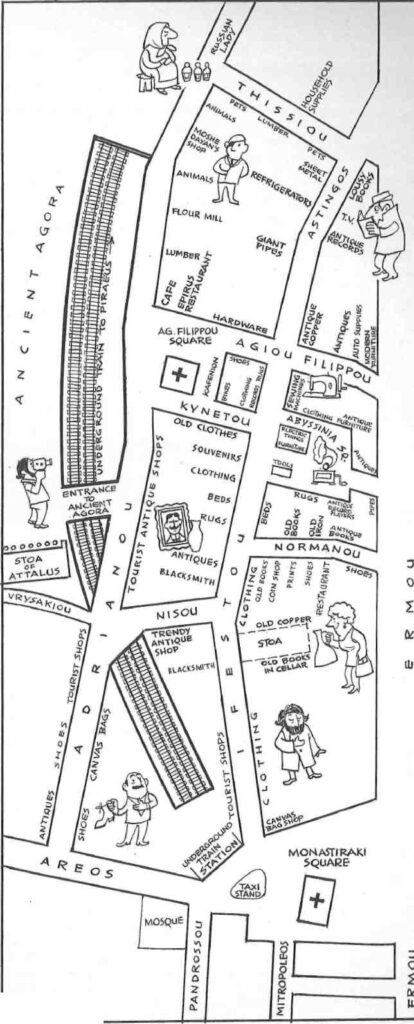
Almost any conceivable thing can be bought there today — at the cheapest prices in Athens. Although the shops are open every day of the week — and for most items weekdays are best — it is on Sundays that the area is most frenetic and becomes a true flea market. Since Monastiraki is only a short distance from Sintagma (Constitution Square), we will begin our walk from that central location.
Both Ermou and Mitropoleos Streets lead to Monastiraki from Sintagma, Mitropoleos being less crowded with more interesting things to see. The little Byzantine Church of the Panagia Gorgoepikoos lies just beside the Mitropolis, the New Cathedral of Athens. Built in the twelfth century, the ‘Old Mitropolis’ is interesting for the many re-used ancient Greek, Roman and early Byzantine marbles built into its exterior walls. The diverse styles and subjects seem to blend into a harmonious whole.
When you reach the corner of Mitropoleos and Eolou, three blocks below the Cathedral, turn left and then take the first right into Pandrossou Street. You can, alternatively, continue down Mitropoleos until you reach Monastraki Square, but Pandrossou, although not strictly part of Monastiraki, is so interesting that a digression is worthwhile because the antique shops and ‘tourist shops’ are innumerable. Shop around before you buy anything and do not be afraid to say that you think the price is too high, which it often is, if you have seen similar items elsewhere for less—but more on bargaining later.
The antique dealers on Pandrossou share certain attributes: they can be amazingly surly, and have little specialized knowledge of antiques, although they try to convey the opposite impression.
Once you have walked the length of Pandrossou, you may wish to visit the Ceramic Collection located in the Tzisdaraki Mosque (the Mosque of the Lower Fountain) — to your left as you enter Monastiraki Square. The building itself is, to be honest, more interesting than the collection inside, and its loggia provides a fine view of the facade of Hadrian’s Library.
Entering Ifestou Street across the Square from Pandrossou, we come into the bazaar area. On the right, at the corner, is a canvas shop which sells shopping bags and replacements for canvas chairs. Most of the shops in the first block on Ifestou sell clothing and shoes. The best buys are heavy walking shoes, everyday shoes, blue jeans, and sportswear. Blue jeans sell, on the average, for one hundred drachmas less than elsewhere in Athens. The jeans ‘made in Greece with American fabrics’ may fall apart faster than imported ones, however, because of the poor thread used to sew them. The work shoes with auto tire soles (you may tell your friends you have Pirelli shoes!) are sturdy and inexpensive. The soles will never wear out even if the uppers do.
Mixed among the ubiquitous tourist shops in this area are vendors of antique and modern copperware. If you buy copper pots intending to use them for cooking, be certain that they are properly lined with tin. Unlined copper pots poison food and the eater.
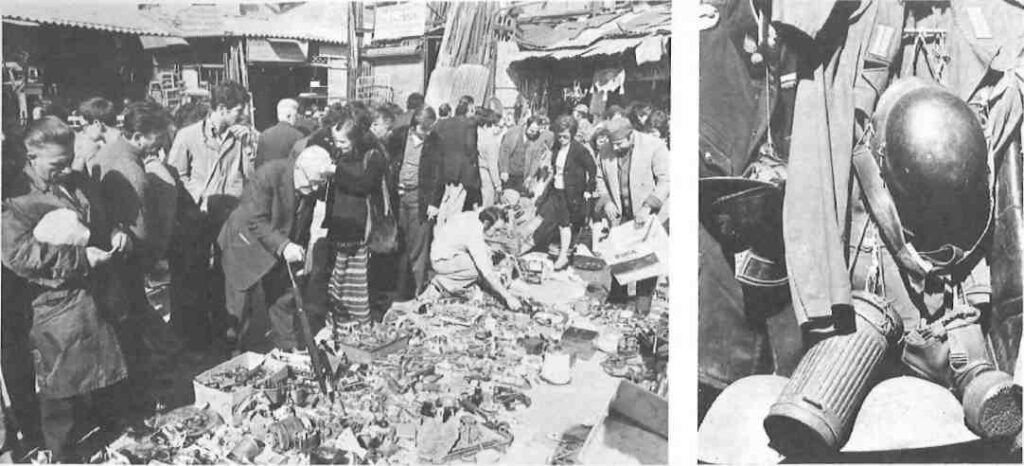
On the left just before the corner of Nisou is the first of several blacksmith shops. These shops make many useful items such as galvanized-steel, barbecue (souvlaki) grills which are very inexpensive and worthwhile (sand placed on the bottom will make a level surface to receive the coal, and protect the metal), tools, fireplace equipment, and hand-forged household attachments of all kinds (hinges, window grilles, ornamental nails, and so on). The current vogue of using iron attachments on doors and in restored houses has surely given these men a new burst of prosperity.
Continuing along Ifestou, and crossing Nisou Street, you will notice a passageway on the right which seems to be lined with books. These belong to a basement bookstore. (Old books usual-ly means used books: a year after it appears in print, a book is an antique and the price ridiculously high.) The passageway also houses a number of copper shops which seem to be rather less expensive than those on the main street. Some very nice items to be found here are modern, copper and brass reproductions of nineteenth-century oil lamps (fully wired electrically and with glass chimneys).
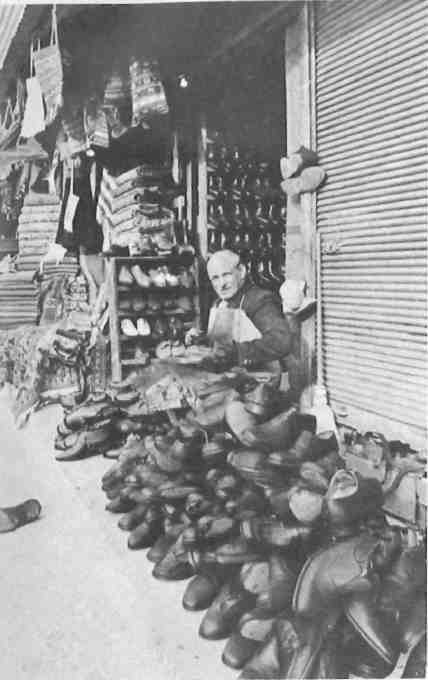
When you arrive at the corner of Normanou Street, turn right and continue to Ermou. Between a restaurant supply shop and a clothing store is a space consecrated to the selling of junk machinery — rusty ball bearings, gears, etc. (Since imported items are expensive, parts of broken-down mechanisms are cannibalized and then resold.) The coin shop on the right (past an old bookshop) is worth a stop: charmingly naive, late-nineteenth to early-twentieth-century pornographic postcards are sold here. The remainder of the shops on the street are devoted to old and very expensive antique books and heating equipment. All manner of petrol and coal stoves are to be found here, as well as on Ermou, complete with outlet pipes and chimneys. (Some of the cast-iron coal stoves are of designs which seem unchanged since the nineteenth century and would certainly be considered chic to have in one’s den or weekend retreat abroad where they probably sell for much more.) A passageway to the right contains a restaurant and a kafenion.
Returning to Ifestou and resuming our walk in the same direction, we come upon an antique shop on the left which is more often than not half closed and where, when open, the proprietors are unwilling to sell anything you may actually want. Next door there is a little snack bar which must be making a fortune. It’s quite new and has already forced the souvlaki stand behind the Church of Agios Filippos to upgrade its quality. Many of the basement shops in this block sell beds and mattresses. The metal bed frames are nothing special but the mattresses are as good as those elsewhere and much less expensive. They are not, however, available in unusual sizes or shapes.
Just after the bed cellars on this side of the street, Ifestou opens up and becomes Abyssinia Square. Platia Άν-issinias’ is named in honour of Haile Selassie’s state visit in the 1930s when he donated to the nation some thoroughbreds which were stabled nearby. Booths selling tools, old copperware, rugs and old furniture line the lower part of the square. To the left are a number of shops which specialize in refinishing old, wooden furniture which, in comparison with the modern furniture available, is surprisingly inexpensive and sturdy. On the right-hand corner of the square, towards Ermou, is a little hole-in-the-wall shop which sells rebuilt gramophones. They can trace their birth to the turn of the century and usually function. Some are works of art, their ‘trumpet’ speakers delicately painted.
On the right, as you leave the square and enter Ermou, is a shop which sells copper vessels by the kilo. You must polish them yourself, but the prices are much lower than at the regular shops. You may also buy enamel-topped, iron folding (kafenion) tables for about one-hundred-and-fifty drachmas at this corner. (Painted and spruced up, they should be nice for garden parties in Psyhiko, Philothei and Kifissia.)
The centre of Abyssinia Square is reserved for the junk men. Their trucks are filled with old clothes, old furniture, old books and magazines which are usually old rubbish! If you have thrown out a chair on Thursday night, it well may be there on Friday or Saturday morning. On occasion, however, you may come upon an amazing bargain since the entrepreneurs must sell all this stuff to realize an immediate return on their investments, so do take advantage of their instinct for a fast turnover.
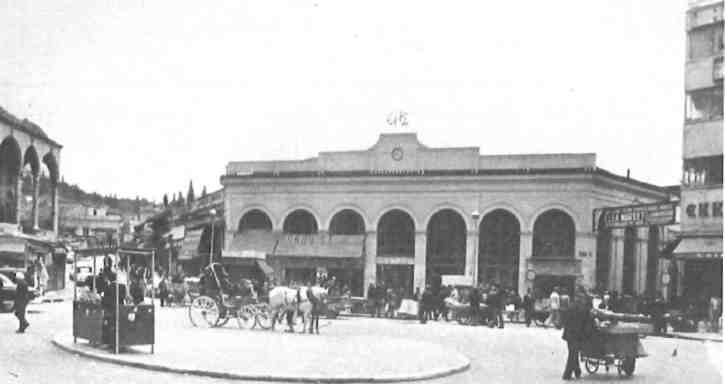
Retracing our steps, we leave the square and turn right onto Ifestou where we come upon a souvlaki stand (not bad), a bicycle shop, a store selling camping equipment, others selling clothing, and another selling sewing machines. Those black-and-gold sewing machines your grandmothers used to use are alive and well in Monastiraki! (In some parts of the world they are now collectors’ items.)
Ifestou ends where it meets Agiou Filippou Street on the right and to the left opens on the little Agiou Filippou Square and its church. Next to the church we find a pleasant open-air kafenion, the end of which is filled with men selling old clothes. Across from the church, at the far corner, at Adrianou, is yet another kafenion, a galaktopolion and, in between, the Epirus Restaurant. While the ambience of this restaurant is reminiscent of an airplane hangar, the food is good. It is frequented at lunch time by archaeologists from the Agora Excavations, but do not let them put you off: they have been known to snap, but they seldom bite.
On Agiou Filippou Street, between Astingos and Ermou, we find contemporary furniture (especially everyday chairs), auto accessories (for example, coloured decals of King Kong carrying a Naked Girl), paints and antiques.
Astingos Street, which begins at Agiou Filippou, is basically an ‘industrial’ street. To the right are shops selling gas burners and stoves (some of the best prices in town), radio and television equipment, ‘antique’ records, and dreadful books. On the left side of the street are giant metal pipe makers, poor quality mattress makers and a shop selling refrigerators and stoves (very good). The used refrigerators, carefully reconditioned and usually carrying sixty to ninety-day guarantees, are a bargain. If they can hold up for that time, they will survive forever. Finally, both sides of the street are filled with shops selling sheet metal.
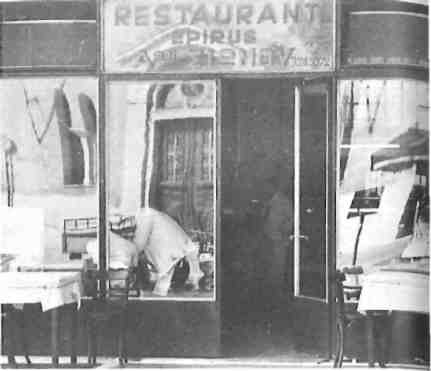
Proceed to the end of Astingos and turn left onto Thisiou where there are several shops selling household supplies, lumber, and pets. Birds are a favourite pet in Greece and the shops on Thisiou and around the corner to the left on Adrianou have a great fluttering selection of these two-legged, feathered friends.
Continue along Adrianou back to Monastiraki Square. Strolling along, you will doubtlessly notice the Agora Excavations and the Stoa of Attalos on your right. You should visit it, but buy a good guidebook (a new edition of the official guide is now available) since it is otherwise a rather confusing area. The museum is excellent and the site is very pleasant to wander in. Should you wish to feed a bit of souvlaki to the Agora Cats (there are two: The Grey One and The Black One) or the Agora Dog (The Black One), you will find them very grateful. (Don’t tease Grey Cat — he is much faster than you are and he has sharper claws.)
Resume your trip along Adrianou until you get to Hadrian’s Library and Monastiraki Square where you will see the usual tourist and antique shops, a little stand selling canvas bags, and a variety of bizarre shoe shops. After this, if you can still walk, turn right and walk around Hadrian’s Library — there are more odd shops up there — or you can just go home and collapse.
On Sundays Monastiraki becomes a flea market par excellence but you must go early and plan an after-lunch siesta that day. The shop owners carry out virtually all their wares onto the streets, and the area, filled with pavement sellers, now extends halfway up Athinas Street. Men with pushcarts, tables, and cloths spread out on the ground sell everything imaginable including glass-ware, thermal underwear, knives, knick-knacks, lighters, shavers, coats, and styrofoam birds with sequin eyes. Ifestou and Adrianou are much the same as on weekdays except that at the end of Adrianou, near the Thision Station, bird sellers and clothes peddlars lay out their wares along the middle of Ifestou. Vrisakiou Street becomes one vast emporium for radios, stereos and electrical goods and Normanou Street spills over with old books and coins. Abyssinia Square becomes a madhouse; you can buy everything from reasonably nice antiques to electrical parts! The greatest transformation occurs on Astingos and Thisiou which come to resemble walk-in rubbish bins! On Astingos you can buy old liquor bottles, old machines, old copper, old Playboy magazines, old tools and sheer junk from a vast assortment. Don’t sneer! You may find something worthwhile (the Playboy man once had a two-volume set of about three-hundred, folio-sized photographs from a pre-World-War-I- German survey of north-ern-Italian Castles, in very good condition and at the startling beginning price of five hundred drachmas!). Thisiou is somewhat less scruffy and tends to favour useful household things at low prices.
On Sunday, Monastiraki is not the place for those who dislike crowds, however, since thousands of people converge on the area to do their week’s shopping. Among the annoyances are two special types to be prepared for: the Shovers and the Stoppers. The Shovers are usually old ladies, second only to mad taxi drivers and sexually frustrated Don Juans in sports cars as the most dangerous moving objects on the streets of Athens. They push even when there is no place for the person they are shoving to move to, and regardless of the fact that the man in front of their victim is carrying a bed on his head. Explaining courteously that you cannot move is useless, but if you abandon restraint and turn around and kick the Dear Old Thing in the shins she may well smile and say pleasantly, ‘Oh, you can’t move because someone’s in front of you!’.
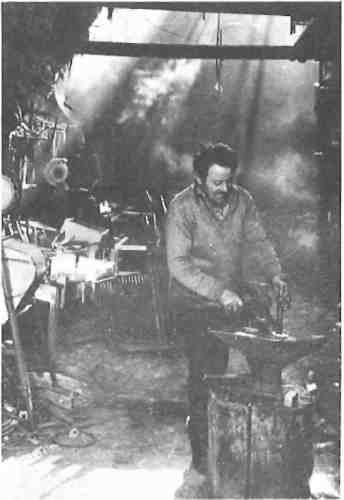
The Stopper is one who suddenly stops motionless in the middle of the street. Chances are that something in his line of vision has caught his interest or, even more likely, that he would like something to catch his interest soon… but does not know what it might be!
Sundays also smoke out various characters. If you hear a weird cry and see a short, stubby, grey-haired man with a big moustache and a funny hat, that will be the Mastika-Chewing-Gum Man — he sells and chews it. On Thisiou you may run into the Wonder Knife Sharpener Man. His sharpeners work but destroy your knives within two years. The Russian Lady, with her lacquered spoons, samovars and little-mother dolls will also be found along here. The Wonder Needle-Threader-Five-Drachmas Man is usually located on Astingos (though he may have moved to Athinas). If you find yourself peering into the face of a very bushy, stumpy guy who glares from behind immense eyebrows, that will be Slippery Sam the Gypsy. He hangs out on Thisiou selling rubbish.
There is also Rasputin: over six feet tall, with long black hair, a black beard, a fur hat and trousers tucked into his boots, he, alas, never knew the Romanovs as far as we know, but he does offer the salvation of lottery tickets.
A short version of Moshe Dayan, patch and all, is Athens’ Finest Typewriter Repairman: he fixes grafomihanes (typewriters) and they stay fixed! His upstairs shop on Adrianou 11, below the Stoa of Attalos, houses a collection of a zillion typewriters with every possible script.
Two final hints if you go on a Sunday: go very early to avoid the crowds and to get first pick of the items for sale (before nine if you can, but certainly before 10:30). Leave small children at home (unless they do not mind being pushed and stepped on): Under no circumstances do you want frightened, crying children on your hands, although you just might be able to sell them.







